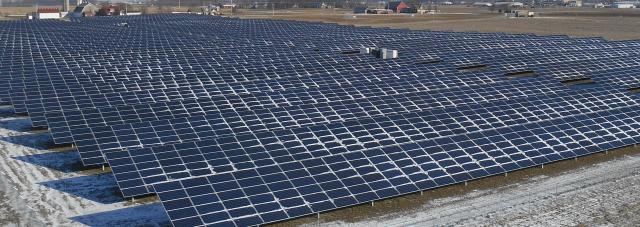Editor’s Note: We are very happy to have this guest post about community solar from David Dwyer, President of American Renewable Energy. Dwyer will speak at the Building Big Solar in Ohio conference to be held in Bowling Green, OH on August 25th. This article originally appeared in Green Energy Ohio News and is used with permission of Green Energy Ohio.
All over the country people recognize that we have a critical task of rebuilding the U.S. economy. A key path to revitalization is the new energy economy and we see it moving like a bullehttp://www.greenenergyoh.org/current-geo-news-magazine/t train. Of the total new U.S. generation capacity added in 2015, solar was 29.5%. Jobs are growing 12 times faster in the solar industry compared to total job growth. Also, overall employment in the U.S. is now higher in solar than oil and gas.
However, with this growth in solar, estimates show that between 65 – 75% of the U.S. population does not have access to solar and its benefits. We also continue to see lobbyists and related policymakers working against the clean energy market. Additionally, only 20 – 30% of homes and businesses have a good site for solar.
The answer to this is community solar with community participation and local ownership. First of all, residents of all incomes as well as non-profit organizations, businesses, religious organizations and others can invest in systems on optimal sites. Customers subscribe to a shared solar facility. A professional developer handles the complex process of approvals, permitting, design, engineering, and installation, etc. The utility is supported with professional monitoring, billing and maintenance services.
Most importantly, community solar with locally sourced inputs is proven to dramatically enhance local economies. A study by the Global Green Growth Institute and the United Nations Industrial Development Organization showed that locally owned renewable energy projects increased the economic benefits by 50 – 240% by keeping jobs in the local community.
An Ontario study demonstrated for every $1.00 spent on a typical renewable community project, it generated $1.45. That number increases to $2.00 when local wages paid by suppliers and investor returns were spent in the community. The Institute for Local Self Reliance (ilsr.org) has found that community-owned renewable energy projects generally create twice as many jobs as corporately owned projects.
Many of you know the story of Minster, Ohio, now the site of one of the largest utility-scale solar energy systems built in the state since the Ohio Senate passed SB 310 in the summer of 2014, crippling the state’s Solar Renewable Energy Credit (SREC) market. Their 4.3 Mw solar generator meets a healthy portion of the municipality’s substantial industrial and commercial demand. When Minster included the 7MW/3MWh Energy Storage System (ESS) in March 2016, the combined solar power and storage became the largest in service for public power in the United States.
As the Village of Minster has realized the financial and energy benefits of their solar utility, they are making big strides toward their goal of community solar and a new paradigm of economic growth. The village government has reached out to its residents with a survey of how they might participate in community solar. They are asking questions such as: What price would you pay? What payment options are desirable? What is your motivation for participating? What more information do you need?
We need to toss off the old model of centralized generation controlled by a few interests. Ohio and our country have an economic opportunity like no other to increase prosperity for all citizens and communities.
David Dwyer


Leave a Reply